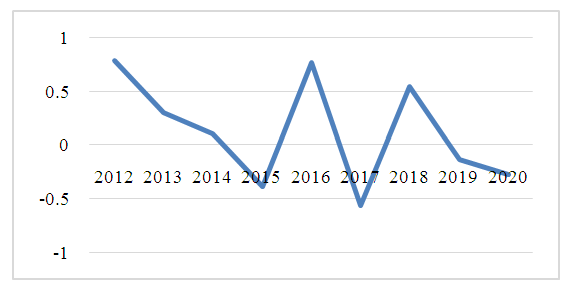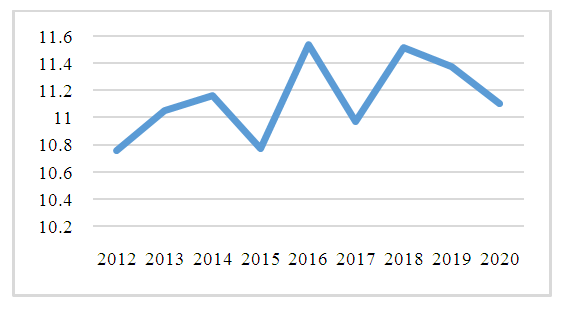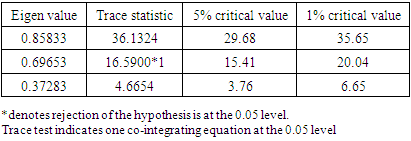-
Paper Information
- Paper Submission
-
Journal Information
- About This Journal
- Editorial Board
- Current Issue
- Archive
- Author Guidelines
- Contact Us
American Journal of Economics
p-ISSN: 2166-4951 e-ISSN: 2166-496X
2022; 12(1): 1-5
doi:10.5923/j.economics.20221201.01
Received: Jan. 19, 2022; Accepted: Feb. 16, 2022; Published: Feb. 25, 2022

Impact of Agricultural Investment in the Economic Growth of Sierra Leone (2001-2020)
Osman Nabay1, P. Venkatesh1, Raymond Bangura Jr2, D. R. Singh1
1Division of Agricultural Economics, ICAR -Indian Agricultural Research Institute, Pusa Campus, New Delhi, Indian
2Biometric Unit, Sierra Leone Agricultural Research Institute, Freetown, Sierra Leone
Correspondence to: Osman Nabay, Division of Agricultural Economics, ICAR -Indian Agricultural Research Institute, Pusa Campus, New Delhi, Indian.
| Email: |  |
Copyright © 2022 The Author(s). Published by Scientific & Academic Publishing.
This work is licensed under the Creative Commons Attribution International License (CC BY).
http://creativecommons.org/licenses/by/4.0/

This study examines the effect of agricultural expenditure and investment in the economic growth of Sierra Leone from 2001-2020. The study mainly used secondary data from the Ministry of Agriculture and Forestry (MAF), Ministry of Finance and Economic Development (MoFED), and other data sourced from the Food and Agricultural Organization (FAO) and the World Bank (WB) for processing and analysis. We used descriptive analysis to show the pattern and trend of investment of individual sectors within the agricultural domain and other sectors that contribute towards the Gross Domestic Product (GDP) in Sierra Leone. In addition, we employed the Augmented Dickey-Fuller (ADF) unit root to test for stationarity in the agricultural output variable. Also, we used the Johansen Co-integration to test for a long-run relationship between government expenditure and agricultural sector output. We used the vector autoregression (VAR) model to present the empirical results for the agricultural sector, government expenditure, and its contribution rate on the GDP. The study recommends that the government invest in the agriculture sector to enhance economic growth in the country.
Keywords: Agricultural sector, Expenditure, Economic growth, Forecast, Investment
Cite this paper: Osman Nabay, P. Venkatesh, Raymond Bangura Jr, D. R. Singh, Impact of Agricultural Investment in the Economic Growth of Sierra Leone (2001-2020), American Journal of Economics, Vol. 12 No. 1, 2022, pp. 1-5. doi: 10.5923/j.economics.20221201.01.
Article Outline
1. Introduction
- Apart from Agriculture, Sierra Leone is rich in minerals, such as; diamonds, rutile, bauxite, gold, iron ore, and bauxite. But, the country is a low-income country with a Gross National Income (GNI) per capita of $1,668 and a Human Development Index (HDI) rank at 182 from 189 countries in 2019 (UNDP, 2020). Agriculture is arguably the leading economic sector as nearly two-thirds of its population depends on it for livelihood and sustenance and is the key factor contributing the largest share of the country’s Gross Domestic Product (GDP) and the largest employer.Agriculture is one of the largest sectors in many developing countries, especially Sierra Leone. According to the world's report, poor people live in rural areas and are primarily engaged in agriculture as a source of their daily livelihood and future development. Therefore, the contribution of agriculture is significant when considering its roles for sustainable development in terms of employment potentials, export earnings, and finances. Ref Ligon and Sadoulet (2008) used panel data to analyse contribution and impact towards the agricultural sector regarding the GDP. Their findings affirmed that the agricultural sector contributes more towards economic growth and development than other sectors. Ref Ebere et al. (2012) analysed the impact of government expenditure on economic growth and agriculture in Nigeria. Their findings show a positive influence between the agricultural output and the GDP, using the ordinary least squares. Chandio A. A. et al. (2018) examined the impact of government expenditure on the agricultural sector and economic growth from 1983-2011 in Pakistan. The empirical result showed that Agricultural output and government expenditure have significant differences in economic progress. They identified challenges faced by the government in terms of inadequate funding, underdeveloped infrastructure, poor agricultural markets, and more. Again, they recommended that government should increase its expenditure on agriculture to improve productivity. Stock and Watson, 2001 defined VAR model as a single-equation, single-variable linear model where the current value of any variable is determined by its lagged values.In developing countries, public expenditure is the main instrument of government in promoting the economic growth necessary for agricultural development. Growth in any economy brings a better standard of living through improved infrastructure, education, health, and expansion in agricultural productivity and food security. Because of this, the study assessed the agricultural investment in the economic growth of Sierra Leone from 2001-2020 through the multivariate time series analysis.
2. Materials and Method
2.1. Data Source and Type
- The principal aim of the study is to examine the impact of the agricultural sector on the economic growth of Sierra Leone from 2001-2020. This research relied mainly on secondary data as time-series data; gross domestic product (GDP) at a constant price, agricultural productivity, and Government expenditure on agriculture. We collected data from Statistics Sierra Leone (SSL), MAF, the Ministry of Finance and Economic Development (MoFED), and FAOSTAT. Agricultural productivity reflects the output of the sub-sectors such as major and minor crops, livestock, Marine resources, fishery, and forestry. Data included the Gross Domestic Product (GDP) at the constant purchased price as the dependent variable, while agricultural sector output and government expenditure are the independent variables. Also, this research made use of related literature through table search and internet surfing to support the empirical analysis.
2.2. Data Analysis
- The researchers used the vector autoregressive (VAR) model to show the relationship between government expenditure, government contribution and the GDP growth rate with their lag differences on the total GDP.
2.2.1. Empirical Model
 Where;GDP = gross domestic product rate
Where;GDP = gross domestic product rate = intercept of GDP
= intercept of GDP = matrices
= matrices = error term
= error term2.2.2. General Hypothesis
 = Government investment has no effect on the in the economic growth of Sierra Leone
= Government investment has no effect on the in the economic growth of Sierra Leone = Government investment has effect on the economic growth of Sierra LeoneWe adopted the Johansen Co-integrated to test the long-run relationship between government expenditure and agricultural output. We used the Augmented Dickey-Fuller unit root to test for stationarity.
= Government investment has effect on the economic growth of Sierra LeoneWe adopted the Johansen Co-integrated to test the long-run relationship between government expenditure and agricultural output. We used the Augmented Dickey-Fuller unit root to test for stationarity. 3. Results and Discussion
- In this section, we present the vector autoregressive model to forecast the impact of agricultural investment in Sierra Leone 2001 to 2020. Table 1 shows a summary result of the vector autoregressive model. We considered three significant factors which are; lag GDP expenditure, lag GDP contribution and lag GDP growth rate as independent variables.
|
3.1. Empirical Impact of Government Investment on Agriculture in the Economic Growth of Sierra Leone
- Table 2 shows the estimates of three factors influencing the GDP. It shows that the expenditure and the growth rate have positive impact on the GDP than government contribution growth rate. We considered the ordinary least square model from SAS procedure to show the relationship between the explained variable (GDP) and the explanatory variables (GDP expenditure rate, GDP contribution rate, and the GDP rate).
|
3.1.1. Augmented Dickey-Fuller Unit Root Test
- We checked for stationarity in the agricultural sector output in the time-series data and the Augmented Dickey-Fuller unit root test procedure in Microsoft excel.Table 3 shows the Augmented Dickey-Fuller unit root test for the natural logarithm of agricultural sector output, government expenditure, and the RGDP. It shows that there is no stationarity for all three variables.
|
3.1.2. Hypothesis for Stationary
 = the agricultural sector needs to be differenced to make it stationary
= the agricultural sector needs to be differenced to make it stationary = the agricultural sector does not need to be differenced to make it stationaryFigures 1 and 2 show the results of the Dickey-Fuller root test in microsoft excel to check lag differences of the agricultural sector variable. It shows that we reject the null hypothesis that the lag of the agricultural sector variable does not need to be differenced to make it stationary. The Lag of Agricultural sector variable with and without difference is stationary at 0.4 and 11.4 respectively.
= the agricultural sector does not need to be differenced to make it stationaryFigures 1 and 2 show the results of the Dickey-Fuller root test in microsoft excel to check lag differences of the agricultural sector variable. It shows that we reject the null hypothesis that the lag of the agricultural sector variable does not need to be differenced to make it stationary. The Lag of Agricultural sector variable with and without difference is stationary at 0.4 and 11.4 respectively. | Figure 1. Lag difference of Agricultural sector |
 | Figure 2. Lag without difference of agricultural sector |
 | Table 4. Parameter output |
3.1.3. Co-integration Unit Root Test
- From table 5, the trace statistic values are greater than the 5% critical values. We reject the null hypothesis from the Johansen Co-integration test with trace statistic. As a result, there is a long-run relationship between agricultural output and government expenditure because the trace statistic results are greater than the 5% critical values.
|
3.2. Discussion
- From the vector autoregressive model, the contribution growth rate in terms of salary structure has a negative impact in the economic growth rate on the GDP. Both the lag expenditure and growth rates are positive effect on the total GDP. It depicts at each GDP there is an approximate increase of government expenditure growth rate at 0.0132. In addition, for every GDP there is an approximate decrease in salary contribution at 0.003. Based on Mill, 1978, the vector autoregressive model is one of the best techniques used to forecast economic pattern. The study ascertained that the agricultural sector is one of the government’s top priorities for the economic growth of the country, Sierra Leone. It is one of the leading investment sectors in the previous and current economic periods.
 Furthermore, the study employed both Augmented Dickey-Fuller unit root tests for stationarity in the agricultural sector variable further detailed in the form of flow chart, showing both differencing in its lag. The results showed that the agricultural sector variable is stationary with or without differencing. Since the agricultural sector caters primarily for the GDP, the government is certainly keen on promoting this sector towards achieving the country’s economic growth. The results showed that the government plans to expand and strengthen its agricultural sector through research with a long-run relationship between the agricultural output and government expenditure but the salary contribution has negative influenced on the GDP in the country. This indicates that government investment in the agricultural sector is obvious towards contributing to the economic growth of Sierra Leone.
Furthermore, the study employed both Augmented Dickey-Fuller unit root tests for stationarity in the agricultural sector variable further detailed in the form of flow chart, showing both differencing in its lag. The results showed that the agricultural sector variable is stationary with or without differencing. Since the agricultural sector caters primarily for the GDP, the government is certainly keen on promoting this sector towards achieving the country’s economic growth. The results showed that the government plans to expand and strengthen its agricultural sector through research with a long-run relationship between the agricultural output and government expenditure but the salary contribution has negative influenced on the GDP in the country. This indicates that government investment in the agricultural sector is obvious towards contributing to the economic growth of Sierra Leone. 4. Conclusions
- We’ve used the vector autoregressive model to demonstrate the relationship among the independent variables and the dependent variable (GDP growth rate). The study revealed that the agricultural investment has a strong impact in the economic growth of Sierra Leone. Also we tested for long run relationship between the Agricultural sector and government expenditure by the Johansen Co-integration test. We checked for stationarity in the agricultural variable through the Augmented Dickey-Fuller method. Based on our findings, we recommend that government should place premium on the salary contribution as it does not positively depict investment impact in the economy. Also, the findings exhibit the significant impact of agricultural investment in the growth of the economy in Sierra Leone.
ACKNOWLEDGEMENTS
- We appreciate the Ministry of Finance, Ministry of Agriculture Forestry and Food Security, and other ministries for providing data for this work. Also, our profound thanks and appreciation extends to Dr. Nithyashree M. L for his suggestions and criticism.
 Abstract
Abstract Reference
Reference Full-Text PDF
Full-Text PDF Full-text HTML
Full-text HTML


